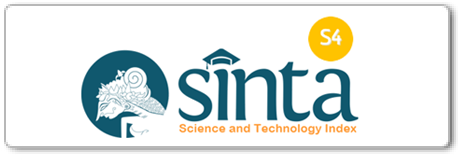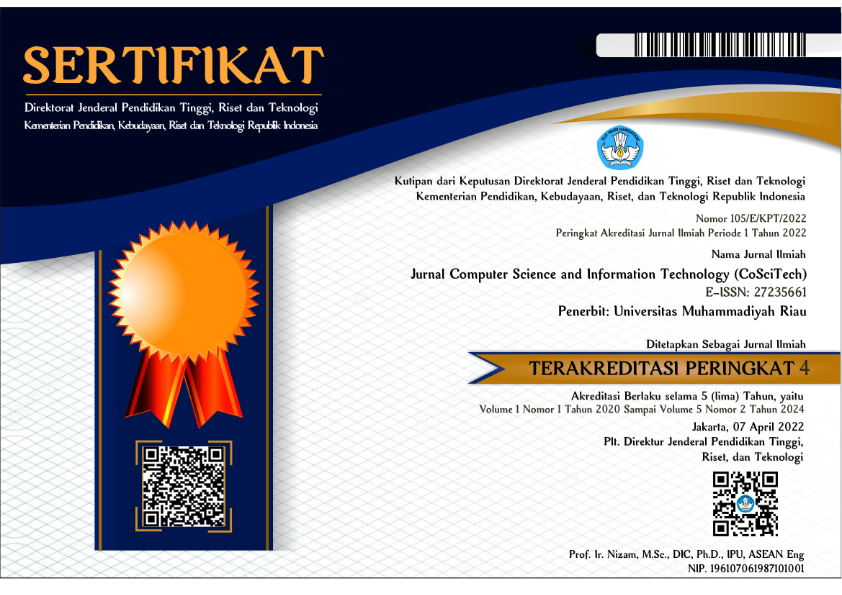Comparative Analysis of Naïve Bayes and K-NN in Determining Location of Mobile Population Services
DOI:
 https://doi.org/10.37859/coscitech.v4i3.6543
https://doi.org/10.37859/coscitech.v4i3.6543
Abstract
Tantangan geografis dan jarak antar desa menjadi kendala dalam pemerataan pelayanan kependudukan dan pencatatan sipil. Hal ini memerlukan intervensi program jemput bola atau layanan keliling. Permasalahannya adalah tidak semua desa dapat terlayani layanan keliling, sehingga perlu dilakukan pemetaan desa-desa yang memenuhi syarat menjadi lokasi layanan keliling. Penelitian ini menjelaskan teknik pembelajaran mesin, khususnya algoritma K-NN dan Naïve Bayes, untuk mengatasi masalah pemilihan lokasi yang memenuhi syarat. Hasil percobaan menunjukkan kedua metode mempunyai tingkat akurasi yang cukup baik, dengan K-NN mencapai tingkat akurasi tertinggi sebesar 97,14% pada dataset yang dinormalisasi dengan metode Normaliasi Min-Max (NMM). Sebaliknya, Naïve Bayes menunjukkan nilai akurasi yang tinggi pada seluruh dataset. Oleh karena itu, penelitian ini merekomendasikan penggunaan algoritma K-NN dengan nilai K=2 untuk menentukan lokasi yang layak menerima layanan kependudukan bergerak.
Downloads
References
[2] Kemendagri, “Peraturan Menteri Dalam Negeri Republik Indonesia Nomor 7 Tahun 2019 tentang Pelayanan Administrasi Kependudukan Secara Daring.” Jakarta, 2019.
[3] Kemendagri, “Peraturan Menteri Dalam Negeri No. 109 Tahun 2019 Tentang Formulir Dan Buku Yang Digunakan Dalam Administrasi Kependudukan.” Jakarta, 2019.
[4] Kemendagri, “Peraturan Menteri Dalam Negeri Republik Indonesia Nomor 72 Tahun 2022 Tentang Standar dan Spesifikasi Perangkat Keras, Perangkat Lunak, Dan Blangko Kartu Tanda Penduduk Elektronik Serta Penyelenggaraan Identitas Kependudukan Digital.” Jakarta, p. 32, 2022.
[5] Dinas Komunikasi Dan Informatika Kabupaten Alor, “Geografis,” alorkab.go.id/, 2022. http://www.alorkab.go.id/new/index.php/profil/geografis1 (accessed Aug. 27, 2023).
[6] E. M. F. El Houby, “A survey on applying machine learning techniques for management of diseases,” J. Appl. Biomed., vol. 16, no. 3, pp. 165–174, Aug. 2018, doi: 10.1016/j.jab.2018.01.002.
[7] S. Mishra, R. Kumar, S. K. Tiwari, and P. Ranjan, “Machine learning approaches in the diagnosis of infectious diseases: a review,” Bull. Electr. Eng. Informatics, vol. 11, no. 6, pp. 3509–3520, 2022, doi: 10.11591/eei.v11i6.4225.
[8] M. E. Febrian, F. X. Ferdinan, G. P. Sendani, K. M. Suryanigrum, and R. Yunanda, “Diabetes prediction using supervised machine learning,” Procedia Comput. Sci., vol. 216, no. 2022, pp. 21–30, 2023, doi: 10.1016/j.procs.2022.12.107.
[9] M. M. Hossin, F. M. Javed Mehedi Shamrat, M. R. Bhuiyan, R. Akter Hira, T. Khan, and S. Molla, “Breast cancer detection: an effective comparison of different machine learning algorithms on the Wisconsin dataset,” Bull. Electr. Eng. Informatics, vol. 12, no. 4, pp. 2446–2456, 2023, doi: 10.11591/eei.v12i4.4448.
[10] K. M. Almustafa, “Prediction of chronic kidney disease using different classification algorithms,” Informatics Med. Unlocked, vol. 24, p. 100631, 2021, doi: 10.1016/j.imu.2021.100631.
[11] R. Safdari, A. Deghatipour, M. Gholamzadeh, and K. Maghooli, “Applying data mining techniques to classify patients with suspected hepatitis C virus infection,” Intell. Med., no. December 2021, 2022, doi: 10.1016/j.imed.2021.12.003.
[12] C. Patgiri and A. Ganguly, “Adaptive thresholding technique based classification of red blood cell and sickle cell using Naïve Bayes Classifier and K-nearest neighbor classifier,” Biomed. Signal Process. Control, vol. 68, no. July 2020, p. 102745, 2021, doi: 10.1016/j.bspc.2021.102745.
[13] D. D. Khudhur and S. D. Khudhur, “The classification of autism spectrum disorder by machine learning methods on multiple datasets for four age groups,” Meas. Sensors, vol. 27, no. March, p. 100774, 2023, doi: 10.1016/j.measen.2023.100774.
[14] K. Polat, S. Şahan, and S. Güneş, “Automatic detection of heart disease using an artificial immune recognition system (AIRS) with fuzzy resource allocation mechanism and k-nn (nearest neighbour) based weighting preprocessing,” Expert Syst. Appl., vol. 32, no. 2, pp. 625–631, 2007, doi: 10.1016/j.eswa.2006.01.027.
[15] A. Yudhana, A. Muslim, D. E. Wati, I. Puspitasari, A. Azhari, and M. M. Mardhia, “Human emotion recognition based on EEG signal using fast fourier transform and K-Nearest neighbor,” Adv. Sci. Technol. Eng. Syst., vol. 5, no. 6, pp. 1082–1088, 2020, doi: 10.25046/aj0506131.
[16] S. Lahmiri, C. Tadj, C. Gargour, and S. Bekiros, “Optimal tuning of support vector machines and k-NN algorithm by using Bayesian optimization for newborn cry signal diagnosis based on audio signal processing features,” Chaos, Solitons and Fractals, vol. 167, no. December 2022, p. 112972, 2023, doi: 10.1016/j.chaos.2022.112972.
[17] I. Konovalenko and A. Ludwig, “Generating decision support for alarm processing in cold supply chains using a hybrid k-NN algorithm,” Expert Syst. Appl., vol. 190, no. December 2020, 2022, doi: 10.1016/j.eswa.2021.116208.
[18] M. P. Vaishnnave, K. Suganya Devi, P. Srinivasan, and G. Arutperumjothi, “Detection and classification of groundnut leaf diseases using KNN classifier,” 2019 IEEE Int. Conf. Syst. Comput. Autom. Networking, ICSCAN 2019, pp. 1–5, 2019, doi: 10.1109/ICSCAN.2019.8878733.
[19] Marisa F et al., “Pengukuran Tingkat Kematangan Kopi Arabika Menggunakan Algoritma K-Nearest Neighbor,” JIMPJurnal Inform. Merdeka Pasuruan, vol. 6, no. 3, pp. 1–5, 2021, [Online]. Available: http://ejurnal.unmerpas.ac.id/index.php/informatika/article/view/280/122
[20] A. Yudhana, D. Sulistyo, and I. Mufandi, “GIS-based and Naïve Bayes for nitrogen soil mapping in Lendah, Indonesia,” Sens. Bio-Sensing Res., vol. 33, pp. 100435:1-100435:11, 2021, doi: 10.1016/j.sbsr.2021.100435.
[21] A. Yudhana, A. D. Cahyo, L. Y. Sabila, A. C. Subrata, and I. Mufandi, “Spatial distribution of soil nutrient content for sustainable rice agriculture using geographic information system and Naïve Bayes classifier,” Int. J. Smart Sens. Intell. Syst., vol. 16, no. 1, pp. 1–14, 2023, doi: 10.2478/ijssis-2023-0001.
[22] T. Setiadi, F. Noviyanto, H. Hardianto, A. Tarmuji, A. Fadlil, and M. Wibowo, “Implementation of naïve bayes method in food crops planting recommendation,” Int. J. Sci. Technol. Res., vol. 9, no. 2, pp. 4750–4755, 2020.
[23] A. Yudhana, R. Umar, and S. Saputra, “Fish Freshness Identification Using Machine Learning: Performance Comparison of k-NN and Naïve Bayes Classifier,” J. Comput. Sci. Eng., vol. 16, no. 3, pp. 153–164, 2022, doi: 10.5626/JCSE.2022.16.3.153.
[24] K. Mitrovic, D. Milosevic, and M. Greconici, “Comparison of Machine Learning Algorithms for Shelter Animal Classification,” SACI 2019 - IEEE 13th Int. Symp. Appl. Comput. Intell. Informatics, Proc., pp. 211–216, 2019, doi: 10.1109/SACI46893.2019.9111575.
[25] A. Yudhana, I. Riadi, and M. R. Djou, “Pengembangan Layanan Kependudukan Dan Pencatatan Sipil Menggunakan Algoritma Naïve Bayes,” JURIKOM (Jurnal Ris. Komputer), vol. 9, no. 4, p. 1062, 2022, doi: 10.30865/jurikom.v9i4.4515.
[26] A. Yudhana, I. Riadi, and M. R. Djou, “Determining eligible villages for mobile services using k- NN algorithm,” vol. 15, no. 1, pp. 11–20, 2023, doi: http://dx.doi.org/10.30865/jurikom.v9i4.4515.
[27] N. Dengen, “Comparison Performance of C4.5, Naïve Bayes And K-Nearest Neighbor in Determination Drug Rehabilitation,” Int. Conf. Sci. Inf. Technol., pp. 112–117, 2019, doi: DOI:10.1109/ICSITech46713.2019.8987455.
[28] S. Yonesa, S. M. Nasution, and R. A. Nugrahaeni, “Path Determination with Classification from Data Mining Using C4.5 Algorithm,” 2018 Int. Conf. Inf. Technol. Syst. Innov. ICITSI 2018 - Proc., pp. 22–25, 2018, doi: 10.1109/ICITSI.2018.8696020.
[29] S. Sunardi, A. Yudhana, and S. A. Wijaya, “Face Detection Analysis of Digital Photos Using Mean Filtering Method,” Int. J. Artif. Intell. Res., vol. 6, no. 2, 2022, doi: 10.29099/ijair.v6i2.307.
[30] C. Schröer, F. Kruse, and J. M. Gómez, “A systematic literature review on applying CRISP-DM process model,” Procedia Comput. Sci., vol. 181, no. 2019, pp. 526–534, 2021, doi: 10.1016/j.procs.2021.01.199.
[31] S. Huber, H. Wiemer, D. Schneider, and S. Ihlenfeldt, “DMME: Data mining methodology for engineering applications - A holistic extension to the CRISP-DM model,” Procedia CIRP, vol. 79, pp. 403–408, 2019, doi: 10.1016/j.procir.2019.02.106.
[32] J. A. Solano, D. J. Lancheros Cuesta, S. F. Umaña Ibáñez, and J. R. Coronado-Hernández, “Predictive models assessment based on CRISP-DM methodology for students performance in Colombia - Saber 11 Test,” Procedia Comput. Sci., vol. 198, no. 2020, pp. 512–517, 2021, doi: 10.1016/j.procs.2021.12.278.
[33] A. Morais, H. Peixoto, C. Coimbra, A. Abelha, and J. Machado, “Predicting the need of Neonatal Resuscitation using Data Mining,” Procedia Comput. Sci., vol. 113, pp. 571–576, 2017, doi: 10.1016/j.procs.2017.08.287.
[34] A. Abubakar and A. B. Garko, “A Predictive Model for Network Intrusion Detection System Using Deep Neural Network,” Dutse J. Pure Appl. Sci., vol. 7, no. 3a, pp. 113–128, 2022, doi: 10.4314/dujopas.v7i3a.12.
[35] Y. A. Setianto, K. Kusrini, and H. Henderi, “Penerapan Algoritma K-Nearest Neighbour Dalam Menentukan Pembinaan Koperasi Kabupaten Kotawaringin Timur,” Creat. Inf. Technol. J., vol. 5, no. 3, pp. 232–241, 2019, doi: 10.24076/citec.2018v5i3.179.
[36] D. Singh and B. Singh, “Investigating the impact of data normalization on classification performance,” Appl. Soft Comput., vol. 97, no. B, p. 105524, 2020, doi: 10.1016/j.asoc.2019.105524.
[37] A. Pérez, P. Larrañaga, and I. Inza, “Supervised classification with conditional Gaussian networks: Increasing the structure complexity from naive Bayes,” Int. J. Approx. Reason., vol. 43, no. 1, pp. 1–25, 2006, doi: 10.1016/j.ijar.2006.01.002.
[38] Rovidatul, Y. Yunus, and G. W. Nurcahyo, “Perbandingan algoritma c4.5 dan naive bayes dalam prediksi kelulusan mahasiswa,” J. CoSciTech (Computer Sci. Inf. Technol., vol. 4, no. 1, pp. 193–199, 2023, doi: 10.37859/coscitech.v4i1.4755.
[39] Fitri Wulandari, Elin Haerani, Muhammad Fikry, and Elvia Budianita, “Analisis sentimen larangan penggunaan obat sirup menggunakan algoritma naive bayes classifier,” J. CoSciTech (Computer Sci. Inf. Technol., vol. 4, no. 1, pp. 88–96, 2023, doi: 10.37859/coscitech.v4i1.4781.
[40] V. Tsenev and M. Ivanova, “Statistical and machine learning approach for evaluation of control systems for automatic production lines,” Bull. Electr. Eng. Informatics, vol. 11, no. 5, pp. 2527–2536, 2022, doi: 10.11591/eei.v11i5.3664.
[41] R. Ritzkal et al., “K-nearest neighbor algorithm analysis for path determination in network simulation using software defined network,” Bull. Electr. Eng. Informatics, vol. 12, no. 4, pp. 2388–2400, 2023, doi: 10.11591/eei.v12i4.4868.
[42] R. Gunawan, R. Septiadi, F. Apri Wenando, H. Mukhtar, and Syahril, “K-Nearest Neighbor (KNN) untuk Menganalisis Sentimen terhadap Kebijakan Merdeka Belajar Kampus Merdeka pada Komentar Twitter,” J. CoSciTech (Computer Sci. Inf. Technol., vol. 3, no. 2, pp. 152–158, 2022, doi: 10.37859/coscitech.v3i2.3841.
[43] A. N. Sadrabadi, S. M. Znjirchi, H. Z. A. Abadi, and A. Hajimoradi, “An optimized K-Nearest Neighbor algorithm based on Dynamic Distance approach,” 6th Iran. Conf. Signal Process. Intell. Syst. ICSPIS 2020, 2020, doi: 10.1109/ICSPIS51611.2020.9349582.
[44] A. Tharwat, “Classification assessment methods,” Appl. Comput. Informatics, vol. 17, no. 1, pp. 168–192, 2018, doi: 10.1016/j.aci.2018.08.003.
[45] A. Sirisha, K. Chaitanya, K. V. S. S. R. Krishna, and S. S. Kanumalli, “Intrusion detection models using supervised and unsupervised algorithms - A comparative estimation,” Int. J. Saf. Secur. Eng., vol. 11, no. 1, pp. 51–58, 2021, doi: 10.18280/ijsse.110106.














